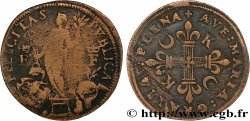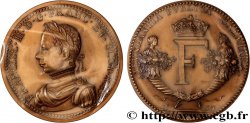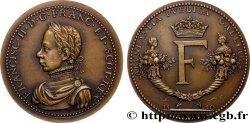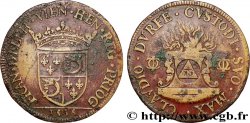fme_412605 - FRANCIS II Médaille, Traité d’Édimbourg, refrappe
Not available.
Item sold on our e-shop (2018)
Price : 120.00 €
Item sold on our e-shop (2018)
Price : 120.00 €
Type : Médaille, Traité d’Édimbourg, refrappe
Date: 1560
Mint name / Town : UK, Édimbourg
Metal : bronze
Diameter : 55 mm
Orientation dies : 12 h.
Weight : 73 g.
Edge : lisse + corne BRONZE
Coments on the condition:
Superbe refrappe avec une agréable patine brune
Obverse
Obverse legend : FRANCISC. II. D. G. FRANC. ET. SCOT. REX.
Obverse description : Buste laurée de François II à gauche.
Reverse
Reverse legend : ABVNDANTIA PVBLICA GALLIAR // 1560 / PAX. CVM. ANCLIS.
Reverse description : F couronné entre deux corne d’abondances personnifiées.
Commentary
Ce type de droit a été utilisé dès le XVIIIe ou XIXe pour des médailles en bronze et en argent, avec au moins un autre revers.
François II (Fontainebleau, le 19 janvier 1544 - Orléans, le 5 décembre 1560), est roi de France du 10 juillet 1559 jusqu'à sa mort l'année suivante.
Fils aîné d'Henri II et de Catherine de Médicis, il monte sur le trône de France à l'âge de quinze ans après la mort accidentelle de son père le 10 juillet 1559. Son règne éphémère n’a duré qu'un an et cinq mois mais constitue un prélude majeur au déclenchement des guerres de religion.
Le traité d'Édimbourg met fin en partie à la Vieille alliance (The Auld Alliance) entre l'Écosse, la Norvège et la France.
Cette alliance avait été renforcée au XVIe siècle par des mariages entre la couronne d'Écosse et celle de France. Mais le parlement écossais, très favorable au protestantisme, avait décidé de mettre fin à la guerre avec l'Angleterre, de reconnaître Élisabeth Ire pour reine d'Angleterre et d'instaurer la nouvelle religion comme culte officiel. La France renonçait, en signant le Traité d'Édimbourg, à tous ses droits sur l'Écosse, ses droits lui venaient par la reine d'Écosse Marie Stuart, épouse de François II de France et fille de Marie de Guise et du roi Jacques V d'Écosse. La mort de François II le 4 décembre 1560 laissait Marie Stuart veuve à 19 ans. Elle passe un accord avec son demi-frère James (fils naturel de Jacques V) le 15 août 1561 qui lui permet de rentrer en Écosse en souveraine à condition de ne pas chercher à rétablir le catholicisme en tant que religion d'État. Ce retour de Marie Stuart sur le trône d'Écosse sera de courte durée puisqu'en 1567, elle sera forcée d'abdiquer au profit de son fils Jacques VI et Ier.
Ainsi se terminait la Vieille alliance entre la France et l'Écosse, même si certaines clauses perdurèrent jusqu'en 1903..
This type of right was used from the 18th or 19th century for bronze and silver medals, with at least one other reverse.
Francis II (Fontainebleau, January 19, 1544 - Orléans, December 5, 1560), was King of France from July 10, 1559 until his death the following year.
Eldest son of Henry II and Catherine de Medici, he ascended the throne of France at the age of fifteen after the accidental death of his father on July 10, 1559.. His short reign lasted only a year and five months but constituted a major prelude to the outbreak of the Wars of Religion..
The Treaty of Edinburgh partially ends the Old Alliance (The Auld Alliance) between Scotland, Norway and France.
This alliance was reinforced in the 16th century by marriages between the crown of Scotland and that of France.. But the Scottish Parliament, very favorable to Protestantism, had decided to end the war with England, to recognize Elizabeth I as Queen of England and to establish the new religion as the official cult.. By signing the Treaty of Edinburgh, France renounced all its rights over Scotland, rights which came to it through the Queen of Scotland, Mary Stuart, wife of Francis II of France and daughter of Mary of Guise and King James V of Scotland.. The death of Francis II on December 4, 1560 left Mary Stuart a widow at the age of 19.. She made an agreement with her half-brother James (the natural son of James V) on 15 August 1561 which allowed her to return to Scotland as sovereign on condition that she did not seek to re-establish Catholicism as the state religion.. This return of Mary Stuart to the throne of Scotland would be short-lived since in 1567, she would be forced to abdicate in favor of her son James VI and I..
Thus ended the Old Alliance between France and Scotland, although some clauses lasted until 1903..
François II (Fontainebleau, le 19 janvier 1544 - Orléans, le 5 décembre 1560), est roi de France du 10 juillet 1559 jusqu'à sa mort l'année suivante.
Fils aîné d'Henri II et de Catherine de Médicis, il monte sur le trône de France à l'âge de quinze ans après la mort accidentelle de son père le 10 juillet 1559. Son règne éphémère n’a duré qu'un an et cinq mois mais constitue un prélude majeur au déclenchement des guerres de religion.
Le traité d'Édimbourg met fin en partie à la Vieille alliance (The Auld Alliance) entre l'Écosse, la Norvège et la France.
Cette alliance avait été renforcée au XVIe siècle par des mariages entre la couronne d'Écosse et celle de France. Mais le parlement écossais, très favorable au protestantisme, avait décidé de mettre fin à la guerre avec l'Angleterre, de reconnaître Élisabeth Ire pour reine d'Angleterre et d'instaurer la nouvelle religion comme culte officiel. La France renonçait, en signant le Traité d'Édimbourg, à tous ses droits sur l'Écosse, ses droits lui venaient par la reine d'Écosse Marie Stuart, épouse de François II de France et fille de Marie de Guise et du roi Jacques V d'Écosse. La mort de François II le 4 décembre 1560 laissait Marie Stuart veuve à 19 ans. Elle passe un accord avec son demi-frère James (fils naturel de Jacques V) le 15 août 1561 qui lui permet de rentrer en Écosse en souveraine à condition de ne pas chercher à rétablir le catholicisme en tant que religion d'État. Ce retour de Marie Stuart sur le trône d'Écosse sera de courte durée puisqu'en 1567, elle sera forcée d'abdiquer au profit de son fils Jacques VI et Ier.
Ainsi se terminait la Vieille alliance entre la France et l'Écosse, même si certaines clauses perdurèrent jusqu'en 1903..
This type of right was used from the 18th or 19th century for bronze and silver medals, with at least one other reverse.
Francis II (Fontainebleau, January 19, 1544 - Orléans, December 5, 1560), was King of France from July 10, 1559 until his death the following year.
Eldest son of Henry II and Catherine de Medici, he ascended the throne of France at the age of fifteen after the accidental death of his father on July 10, 1559.. His short reign lasted only a year and five months but constituted a major prelude to the outbreak of the Wars of Religion..
The Treaty of Edinburgh partially ends the Old Alliance (The Auld Alliance) between Scotland, Norway and France.
This alliance was reinforced in the 16th century by marriages between the crown of Scotland and that of France.. But the Scottish Parliament, very favorable to Protestantism, had decided to end the war with England, to recognize Elizabeth I as Queen of England and to establish the new religion as the official cult.. By signing the Treaty of Edinburgh, France renounced all its rights over Scotland, rights which came to it through the Queen of Scotland, Mary Stuart, wife of Francis II of France and daughter of Mary of Guise and King James V of Scotland.. The death of Francis II on December 4, 1560 left Mary Stuart a widow at the age of 19.. She made an agreement with her half-brother James (the natural son of James V) on 15 August 1561 which allowed her to return to Scotland as sovereign on condition that she did not seek to re-establish Catholicism as the state religion.. This return of Mary Stuart to the throne of Scotland would be short-lived since in 1567, she would be forced to abdicate in favor of her son James VI and I..
Thus ended the Old Alliance between France and Scotland, although some clauses lasted until 1903..








 Report a mistake
Report a mistake Print the page
Print the page Share my selection
Share my selection Ask a question
Ask a question Consign / sell
Consign / sell
 Full data
Full data









